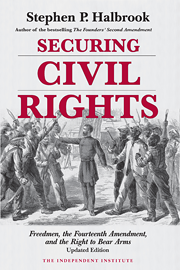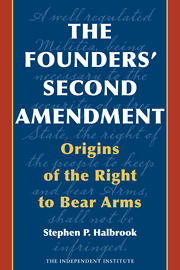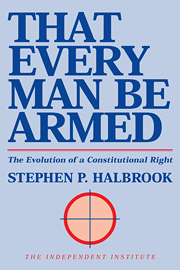The Seventh Circuit heard oral argument on November 12 in Viramontes v. County of Cook, Illinois, a challenge to Cook County’s ban on semiautomatic rifles like the AR-15, inaccurately labeled as assault weapons. These bans are flatly unconstitutional under Heller, which establishes that the law-abiding citizens of this Nation have a right to possess firearms that are in common use. Semiautomatic rifles undoubtedly are in common use—indeed, the AR-15 has been the best-selling rifle in the Nation for years. Unfortunately, the Seventh Circuit departed from Heller in a case called Bevis to hold that arms that are predominantly useful for military purposes can be banned. But even under that reasoning, semiautomatic rifles cannot be banned. They are common civilian firearms, not military firearms, because they lack the capacity for automatic and burst fire.
The questioning at the Seventh Circuit, however, did not focus much on the merits of the case. Rather, the panel (consisting of Judges Sykes, Brennan, and St. Eve) took a surprise detour through a series of procedural objections put forward in Cook County’s briefs. (Take a listen here). Judges Sykes and St. Eve appeared to think that Viramontes’ challenge should fail because he didn’t put forward critical evidence about semiautomatic rifles in the district court. Viramontes’ lawyer challenged that notion, including by citing to specific pages in the record containing key pieces of evidence. I decided to dig deeper into the history of the case to see who has the better of the argument. The short answer is that Viramontes does. Indeed, he has built one of the most robust records I have seen by a plaintiff in a case challenging a semiautomatic rifle ban.
Procedural History
Before turning to the record, it is helpful to take a step back to see how we got to this point. When Viramontes filed his case, the constitutionality of a ban on semiautomatic rifles was controlled by two Seventh Circuit precedents, Wilson and Friedman. Viramontes did not initially seek to build a record in the district court because his sole path to victory was to have the Seventh Circuit or U.S. Supreme Court declare that Wilson and Friedman were wrongly decided.
Cook County, however, requested the opportunity to build a record, and the district court obliged. Then, while the case was proceeding in the district court, the U.S. Supreme Court decided Bruen, arguably wiping out Wilson and Friedman as precedent. It was in this context that the parties put forward their evidence and engaged in summary judgment briefing. It was not until summary judgment was fully briefed that the Seventh Circuit decided Bevis, and the parties addressed that decision in short filings.
Summary Judgment Briefing
Viramontes and Cook County both filed summary judgment motions. In those motions, the parties differed in how they presented the materials that they claimed supported their affirmative cases. All the key facts at issue in the case are what are called legislative facts—that is, general facts about the world that are not specific to the parties in the action, such as the overwhelming extent to which law-abiding citizens own semiautomatic rifles and why they own them. The Seventh Circuit has said that legislative facts may either “be incorporated in the argument section of [a] brief” or “in [a] statement of facts.” Wiesmueller v. Kosobucki, 547 F.3d 740, 742 (7th Cir. 2008).
Viramontes chose the first option. Thus, in the argument section of his summary judgment brief, he cited legislative fact materials that he claimed entitled him to prevail, including: surveys about the possession of semiautomatic rifles by the Washington Post, the National Shooting Sports Foundation, and William English; information about the criminal misuse of firearms from sources like the U.S. Department of Justice and scholarly publications; and information about the distinction between automatic and semiautomatic fire and the defensive value of the latter from sources like the U.S. Army and scholarly publications.
Cook County chose the second option, putting in a lengthy statement of material facts setting forth its legislative fact material. Viramontes, accordingly, responded to Cook County’s statement by identifying contrasting legislative fact material. This is expressly contemplated in the local rules, which provide that a response to a statement of material facts may include facts that are “fairly responsive to the asserted fact to which the response is made.” N.D. Ill. LR 56.1(e)(2). Viramontes’ response to Cook County’s statement of facts is a 105-page document, backed by 105 exhibits spanning over 2,000 pages.
All of the specific sources referenced in the Seventh Circuit argument on November 12 can be found in these exhibits:
- Gregory Wallce, “Assault Weapon” Lethality, 88 Tenn. L. Rev. 1, 13–14 (2020): dkt. 98, ex. 12 (PageID 1835).
- Dennis P. Chapman, The AR-15 Controversy: Semiautomatic Rifles and the Second Amendment (2nd ed. 2022): dkt. 98, ex. 82 (PageID 3117).
- William English, 2021 National Firearms Survey: Updated Analysis Including Types of Firearms Owned at 33–34, Geo. Univ. (May 13, 2022): dkt. 98, ex. 15 (PageID 2004).
- Poll of current gun owners, Wash. Post-Ipsos (Mar. 27, 2023): dkt. 98, ex. 16 (PageID 2051).
- Commonly Owned: NSSF Announces Over 24 Million MSRS in Circulation, NSSF (July 20, 2022): dkt. 98, ex. 50 (PageID 2639).
These sources establish that semiautomatic rifles like the AR-15 are commonly-possessed firearms that law-abiding citizens keep in their homes for self-defense; that the military does not use semiautomatic-only rifles as standard service rifles; and that automatic fire is used for military operations that require laying down suppressive fire. There is much else besides, and material from the exhibits is referenced in the responses to the statement of facts, which are then incorporated as appropriate into the response to Cook County’s summary judgment brief.
Assessment
Having reviewed the record, Viramontes’ lawyer was clearly right: Viramontes built a substantial record in the district court; Cook County had ample opportunity to address the materials in the record; and Viramontes should prevail based solely on the materials in that record.
Of course, because legislative facts are at issue there is no reason to limit the materials considered by the Court of Appeals to what was in the district court record. Both Viramontes and Cook County supplemented those materials with new materials in their appellate briefing. But regardless of whether a broader body of information or only the district court record is considered, Viramontes should prevail, whether under the Bevis test or under the Heller common use test. My hope is that the Seventh Circuit does not get sidetracked by spurious procedural objections but instead decides the case that has been presented to it on the merits.
















